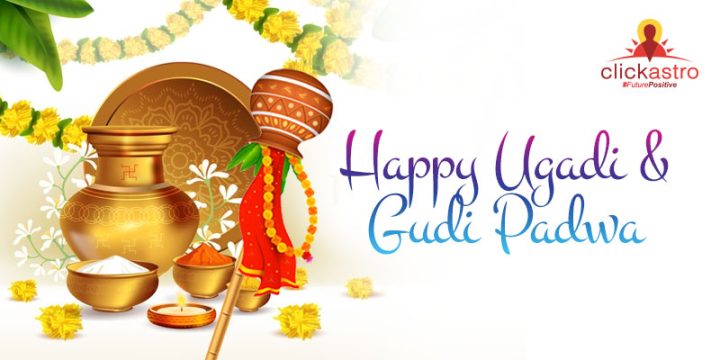New Year across the globe is celebrated in January. In India, where Hindus make up the majority of the population, the Hindu New Year in a calendar is observed on different dates among different communities. If we are to ask which date is the Hindu New Year, one can never get a common or single answer to this question. Hinduism encompasses many different cultures, each of which follows a distinct calendar with the New Year’s Day based on the local agrarian economy and seasonal changes. Thus the New Year dates fluctuate yearly in some lunar calendars; however, the Hindu New Year is largely observed in March and April.
The Ugadi festival marks New Year’s Day in the
Luni-Solar calendar. It is primarily observed in the states of Andhra Pradesh, Telangana, and Karnataka. In Maharashtra, it is celebrated as Gudi Padwa by the Marathas. In the area between the Kaveri River and the Vindhya Mountains, where the southern
Luni-Solar calendar is used, the
Ugadi/Gudi Padwa festival is observed.
In contrast to the Solar Calendar, which only takes into account the position of the Sun, the Luni-Solar calendar calculates the months and days in a year using the positions of both the Sun and the Moon. Thus Ugadi or Gudi Padwa marks the astrological New Year for the people of these regions and is celebrated with huge fanfare. In Karnataka, it is also referred to as Yugadi.
Read
Stars and Planets – Their Positions, Directions and Influence
When is Ugadi and Gudi Padwa in 2024?
The date of Ugadi 2025 is determined by calculating the position of the Moon. The day that follows the first New Moon after the Spring Equinox is celebrated as the New Year or Ugadi.
In 2025, the Spring Equinox falls on March 20th, Thursday, while Ugadi/Gudi Padwa falls on March 30, Sunday.
The Ugadi event is a public holiday in the Andhra Pradesh, Tamil Nadu, and Telangana regions. Ugadi marks the beginning of a new Samvatsara, and there are 60 Samvatsaras in a cycle, each bearing a unique name. The
Samvatsara for 2025 is called the Krodhi Nama Samvatsara. The date of Ugadi was determined by the famed mathematician Bhaskaracharya using astronomical calculations in the 12th century.
What is the Astrological Relevance of Ugadi?
The first day of Chaitra, the first month of the Hindu lunisolar calendar, coincides with the
Ugadi festival. In the Gregorian calendar, it typically falls in March or April. The word “Ugadi” (pronounced “Yug-adi”) refers to the start of a new era. It originates from the Sanskrit words “yuga,” which means age, and “adi,” which means beginning. Ugadi is the first day of the first
Shukla paksha (waxing phase) of the astrological new year. Some communities in North India also celebrate this occasion as the New Year. For instance, this event is known as “Cheti Chand” by the Sindhis, who celebrate it as their new year. A region’s lunar day begins and ends based on the Moon’s position in relation to that region.
The Gudi Padwa festival, also known as Ugadi, is sometimes celebrated one Gregorian day earlier. Unlike Solar calendars, Luni-Solar calendars divide the year into months and days based on the positions of the Moon and Sun. Thus, the New Year occurs twice in the Luni-Solar calendars and is observed in India’s various regions according to various names and customs.
A Samvatsara, rather than a year, begins on Ugadi. Jupiter moves through one sign in the Ugadi horoscope in one Samvatsara, which is roughly equivalent to one year. Jupiter moves closer or farther away from the Earth with each sign, which has an impact on Earth’s population. Each Samvatsara is distinct up until Jupiter completes a total of five complete rotations of the zodiac, or sixty Samvatsaras. At that time, Jupiter and Saturn both pass through the 0-degree of Aries, indicating the conclusion of one cycle and the start of the subsequent one.
The Legend Behind Ugadi
In pre-ancient times, during Satya Yuga, humanity had lost all moral virtues and lived like animals. So, Lord Vishnu decided to end the world with a deluge. Lord Brahma was to start a new civilization then. Key instructions for this new civilization were handed over to Lord Brahma by Lord Vishnu in the Vedas. A demon called Somakasura stole the Vedas from Brahma and hid them deep in the ocean. Lord Vishnu took the Matsya Avatar, killed the demon, and retrieved the Vedas. Having got back the Vedas, Lord Brahma started the creation of the new world on Ugadi day. Another legend says that the occasion commemorates the coronation of Rama in Ayodhya after his victory over Ravana.
Going by astrology, Ugadi day was the most auspicious time to start the new emperor’s reign. The nine-day-long spring festival of Vasanta Navratri begins on this day and concludes on
Ram Navami. Yet another legend is that Lord Krishna left his mortal abode on Ugadi day. Since it is generally believed that Lord Krishna’s death signaled the arrival of Kali Yuga, Ugadi day also signifies the start of Kali Yuga. It has to be noted that Ugadi day marks the only auspicious occasion in Vedic culture where Lord Brahma is worshipped for his role in the sustenance of the world.
Ugadi Celebrations
The festival is enthusiastically observed by the Telugu, Kannada, Marathi, Kodava, Tulu, and Konkani diaspora throughout India. They celebrate it with lavish feasts and family get-togethers. The festivities include decorating doors with mango leaves in the form of Toranalu (also known as Toranagalu in Kannada), drawing colorful patterns on the floor known as Kolamulus (also known as Rangoli), buying and giving new clothes, taking a special bath followed by oil treatment, visiting temples, helping the needy, and preparing and sharing special foods. It is customary for people to wash the front of their homes with water, apply cow dung paste, and draw vibrant floral patterns. Mango leaves are also used to adorn front doors.
A significant tradition is making special dishes like pulihora, bobbatlu (bhakshalu/polelu/oligalu), burelu, and pachadi. A key ingredient in these foods may be the raw mango, which is abundant at this time of year. The most notable of the special Ugadi dishes is Pachadi. It is a dish that resembles chutney and contains ingredients that are sweet, sour, tangy, and bitter. It serves as a symbolic reminder that the upcoming New Year will bring with it a variety of experiences and complicated life phases. The components of pachadi — jaggery or brown sugar, neem flowers, salt, tamarind, or raw mango — provide the dish with its many distinct flavors.
Importance of Gudi Padwa

Maharashtra’s Gudi Padwa festivities are comparable to those of Ugadi or Yugadi. The term “Gudi Padwa” was created from the Sanskrit words ‘gudi’, which means flag, and ‘pāḍavā’ derived from the Sanskrit word ‘pratipad’, meaning the first day of the lunar fortnight. On this day, a special Gudi flag will be raised, decorated with flowers, mango and neem leaves, and sugar crystals, and topped with an upside-down silver or copper vessel. It represents prosperity, success, and victory. The Gudi is then placed outside the home, in a prominent location such as a window or a balcony, facing the east direction.
The day begins with an early morning ritual bath, followed by the decoration of the Gudi and a puja (worship) ceremony. The puja involves the offering of neem leaves, jaggery, and gram dal to the deity, along with the recitation of mantras and hymns. The Gudi is then worshipped with offerings of flowers, coconut, and incense sticks.
The festival is also marked by traditional food preparations such as Puran Poli, Shrikhand, and Poori Bhaji, which are served to family and friends. People also wear new clothes, visit temples, and exchange greetings and gifts with their loved ones.
In some parts of Maharashtra, particularly in rural areas, people also celebrate the festival by participating in processions and cultural programs, which include folk dances such as Lavani and Dindi. In cities like Mumbai and Pune, Gudi Padwa is celebrated with great enthusiasm, with events such as street fairs, concerts, and cultural performances.
The Gudi Padwa festival marks the beginning of spring and the rabi crop harvest. The Shalivahan dynasty’s Gautamiputra Satakarni defeated the Sakas on this day in 78 A.D. The legendary warrior king Chhatrapati Shivaji re-started the celebration of Gudi Padwa after his victory over the Mughals. Today Gudi Padwa is celebrated with much enthusiasm in Maharashtra and Goa. Families decorate their homes in anticipation of an excellent year ahead. Bright-coloured clothes are worn, and people spend the day laughing and refreshing happy memories from the past.










interesting post